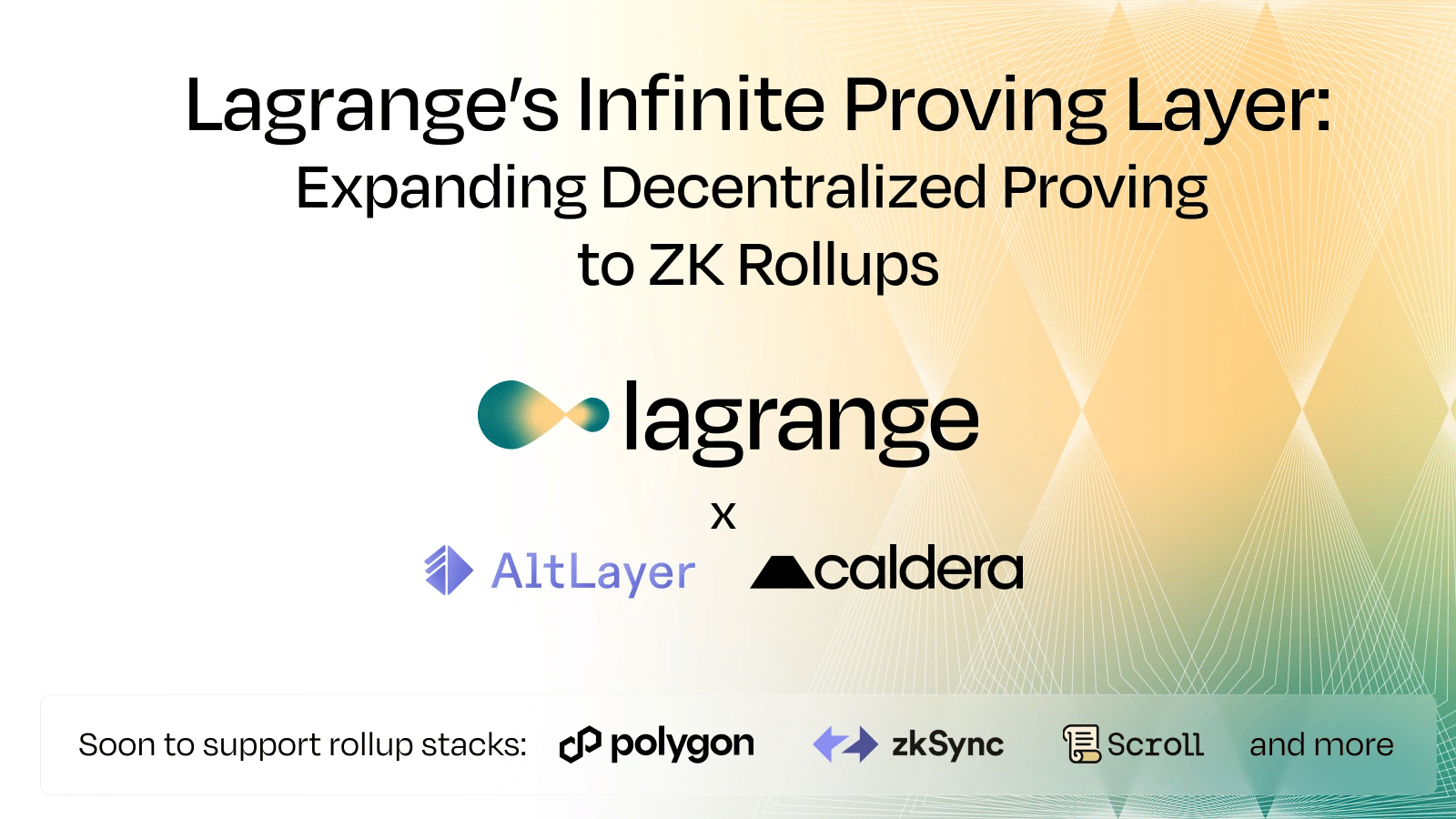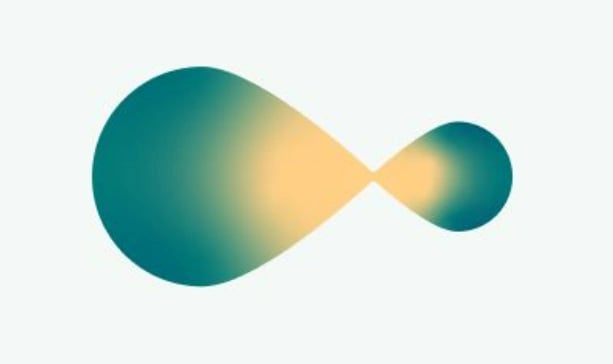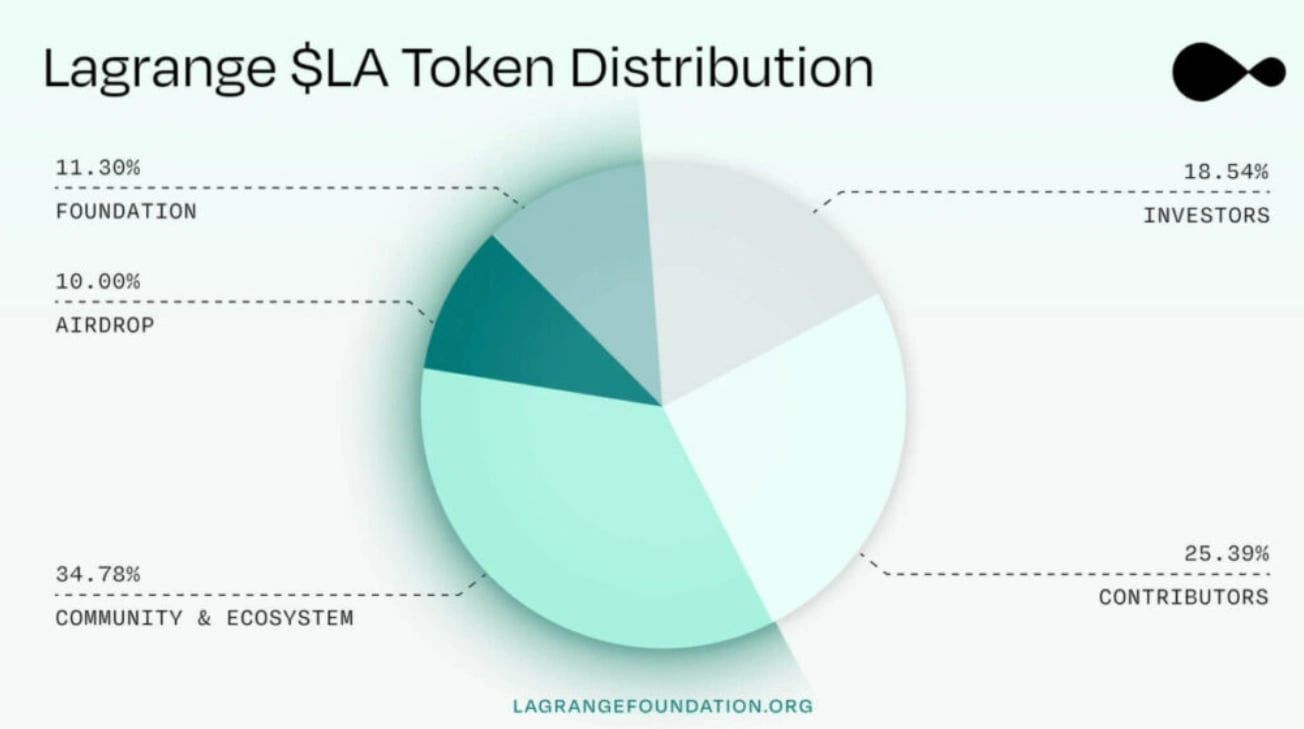Lagrange
Lagrange is a blockchain infrastructure project that provides a zero-knowledge proof (ZKP) layer, combining a decentralized ZK Prover Network and a ZK Coprocessor. Its purpose is to enable scalable cryptographic verification for various applications, including blockchain rollups and artificial intelligence [1].

Overview
Lagrange aims to address key challenges in the blockchain and AI verification space, particularly concerning scalability, resource allocation, and verifiable computation. A core component of its economic model is the $LA token, designed to align the interests of network participants: clients, provers, and token holders. The token facilitates fee payments for proof requests and serves as a reward mechanism for provers, linking proof demand directly to token demand. Lagrange also focuses on expanding the capabilities of smart contracts by enabling verifiable database queries and complex computations off-chain, verifiable on-chain, and extending this verification capability to AI outputs. [1] [4]
Lagrange Foundation
Established in May 2025, the Lagrange Foundation is an independent entity dedicated to the growth of the Lagrange ecosystem [2] [1]. It is tasked with the maintenance and administration of the Lagrange Prover Network, overseeing its day-to-day operations [2]. The foundation aims to foster the development of important use cases for Lagrange technology, including verifiable AI, scalability for ZK Rollups, and coprocessing [2]. Ecosystem projects can expect support from the foundation in areas such as business development, marketing, technical guidance, and advisory services [2].
The Lagrange Foundation and Lagrange Labs are separate organizations with different goals [2]. While Lagrange Labs acts as an active developer for the Lagrange Prover Network, it does not hold any governance position or responsibility over the network’s operations [2]. Lagrange Labs focuses on the research and development of new technologies that expand the scalable use of ZK proof generation and verifiable AI, with the results of these efforts being applied to the Lagrange Prover Network to drive ecosystem growth [2]. The establishment of the foundation ensures sustainable governance and ecosystem development [1].
EigenLayer Based ZK Proofs
Lagrange Labs builds on Ethereum’s EigenLayer restaking framework to support scalable and trust-minimized zero-knowledge (ZK) computation. By leveraging EigenLayer’s restaked ETH for economic security, Lagrange enables decentralized applications to offload resource-intensive computations to a network of offchain nodes known as "coprovers." These nodes generate ZK proofs that allow verifiable results without requiring direct trust. With over $6 billion in restaked assets securing the network, Lagrange’s approach enhances performance for big-data computations that are otherwise inefficient onchain. The team continues to align its infrastructure with developments in the EigenLayer ecosystem. [3]
ZK Rollups

Lagrange has extended its decentralized ZK Prover Network to support zero-knowledge (ZK) rollups, offering scalable and censorship-resistant proof generation for blockchain applications. This expansion allows rollups, applications, and coprocessors to access decentralized proving infrastructure, mitigating the risks of centralized proof generation such as single points of failure. Lagrange distributes computational tasks across a network of independent operators, providing dedicated bandwidth to each rollup and ensuring high availability even under peak demand. The modular “network of networks” architecture supports a variety of proof systems and enables chains to scale without input/output limitations. Initially supporting AltLayer and Caldera, Lagrange plans to expand to zkSync, Polygon CDK, and Scroll. With this infrastructure, Lagrange facilitates verifiable computation at scale and simplifies integration through a single proof request interface. [4]
Key Features
- Modular Architecture: Employs a "network of networks" design intended to provide scalability by using modular subnetworks [1].
- DARA Mechanism: Utilizes the Double Auction Resource Allocation (DARA) system for managing resource allocation in the decentralized proving marketplace [1].
- Universal ZK Coprocessor: Provides capabilities for smart contracts to query and compute on provable databases containing blockchain data subsets using SQL [1]. This supports both transactional (OLTP) and analytical (OLAP) workloads [1].
- Production-Ready Infrastructure: Operates with over 85 institution-grade operators on EigenLayer, designed to ensure proof liveness through economic incentives and potential slashing penalties for non-performance [1].
- Universal Proving Support: Designed to support various proof systems, including Boojum, Plonky2, and Plonky3 [1].
Technology
Lagrange's infrastructure is built upon two main components:
- Decentralized ZK Prover Network: A network of provers responsible for generating zero-knowledge proofs [1]. The network's modular design allows for dedicated bandwidth and support for varied proving demands [1].
- Hyper-Parallel ZK Coprocessor: Enables smart contracts to perform complex database queries and computations off-chain with cryptographic proof [1]. It creates provable databases from blockchain data that can be queried using standard SQL [1].
The DARA (Double Auction Resource Allocation) mechanism is a market mechanism used for allocating resources within the decentralized proving marketplace [1]. It is designed to manage the interaction between proof requesters and provers, aiming for efficient resource distribution and truthful bidding [1].
Lagrange also includes DeepProve, a technology aimed at enabling verifiable AI by allowing users to request cryptographic proof of AI output correctness [1].
Use Cases
- ZK Rollup Scalability: Provides proof generation services for ZK rollups to enhance their scalability [1].
- Verifiable AI: Through DeepProve, it enables the verification of AI computations and outputs with cryptographic proofs [1].
- Cross-Chain Data Verification: The ZK Coprocessor allows smart contracts to process and verify data across multiple EVM-based chains without relying on bridges [1]. This enables computations like averages or analytics spanning different networks with cryptographic guarantees [1].
- Complex Smart Contract Computations: Facilitates off-chain computation for smart contracts that can be verified on-chain, supporting complex applications like DeFi protocols or advanced analytics [1].
Tokenomics

Lagrange Token ($LA)
The $LA token has a total supply of 1,000,000,000 tokens and a fixed annual emission rate of 4%, allocated to provers based on proof generation [1]. At the Token Generation Event (TGE), 19.3% of the total supply became immediately available [1].
- Community & Ecosystem: 34.78% [1]
- Contributors: 25.39% [1]
- Investors: 18.54% [1]
- Foundation: 11.30% [1]
- Airdrop: 10.00% [1]
Tokens allocated to early contributors and investors were locked for one year after TGE. Thereafter, early contributors and investors will unlock linearly over two years [1]. Tokens allocated to community and ecosystem had 5% of the total supply initially unlocked at TGE [1]. The remainder of community and ecosystem tokens were locked for 6 months, followed by a 48-month linear unlock [1].

Token Utility
- Fee Payment: It is the native currency for paying fees for proof generation requests within the Lagrange network [1].
- Prover Incentives: Provers receive compensation exclusively in $LA tokens, regardless of the original payment currency [1].
- Staking and Delegation: Token holders can stake or delegate $LA to specific provers, directing emission subsidies to reduce proving costs for chosen operators [1]. This mechanism serves as a secondary supply sink, reducing circulating supply while allowing stakeholders to influence network economic priorities [1].
- Network Security: The staking mechanism locks tokens and creates economic incentives for network security [1]. Provers must maintain performance standards or face potential slashing, while delegators share in rewards based on their chosen provers’ performance [1].
